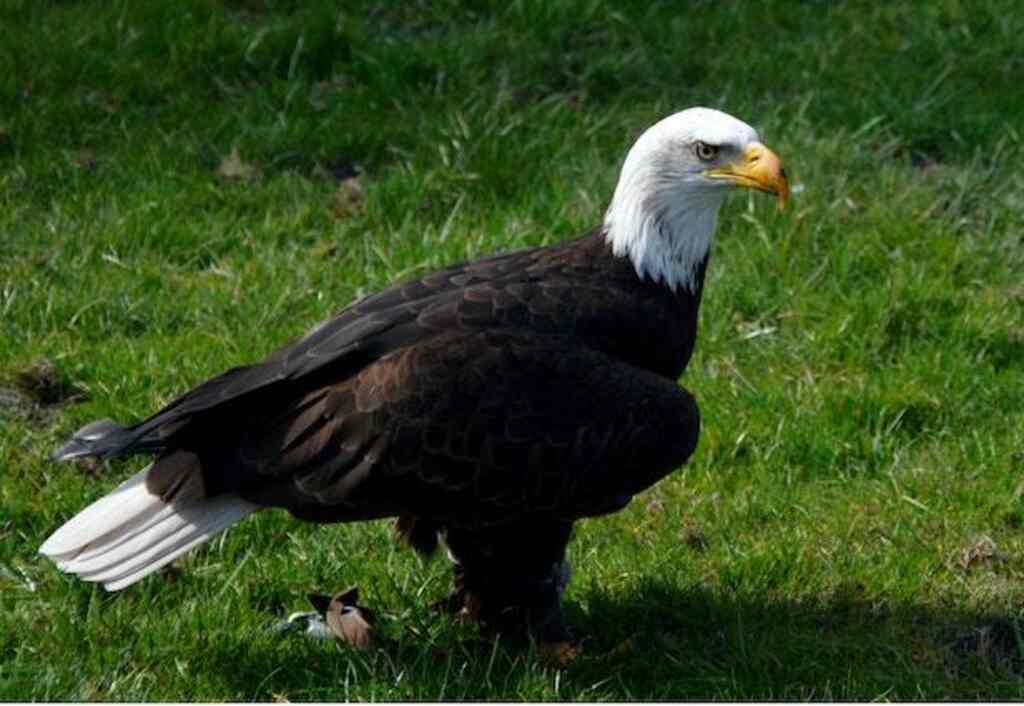Eagles are known for their hunting skills and carnivorous diet, but have you ever wondered if they eat anything else besides meat? Specifically, do eagles eat grass?
While the short answer is no, there are interesting nuances to their eating habits that are worth exploring. Join us as we take a closer look at why eagles primarily consume meat and the amazing facts surrounding their diet.
Table of Contents
- 1 Key Takeaways
- 2 Do Eagles Eat Grass
- 3 Overview of Eagle’s Diet
- 4 Carnivorous Diet of Eagles
- 5 Habits of Scavenging
- 6 Role of Carrion in their Diet
- 7 Consumption of Fish
- 8 Feeding on Small Mammals and Birds
- 9 Omnivorous Tendencies
- 10 Grass-eating Behavior in Eagles
- 11 Reasons for Grass Consumption
- 12 Scientific Studies on Grass-eating Eagles
- 13 Conclusion: Do Eagles Actually Eat Grass?
- 14 Frequently Asked Questions
- 14.1 Are there any scientific studies that have been conducted on eagles’ grass-eating behavior?
- 14.2 What are the reasons behind eagles’ consumption of grass?
- 14.3 Do eagles feed on small mammals and birds as part of their diet?
- 14.4 How do eagles scavenge for food, and what role does carrion play in their diet?
- 14.5 Do eagles have any omnivorous tendencies in addition to their carnivorous diet?
- 15 Author
Key Takeaways
- Eagles are primarily carnivorous, with their diet consisting mainly of animal prey.
- Grass does not provide eagles with the nutrients they need, so they do not consume it regularly.
- While eagles may occasionally ingest grass while consuming their prey, it is not a significant part of their diet.
- The lack of nutritional value in grass is one reason why it is not a part of eagle’s typical diet.

Do Eagles Eat Grass
Eagles do not usually eat grass, as it lacks the nutrients they need. They are primarily carnivorous, with their diet mainly consisting of animal prey such as small mammals, fish, and birds.
While they may occasionally ingest grass unintentionally while consuming their prey, it is not a significant part of their diet.
Overview of Eagle’s Diet
Eagles primarily consume a diet consisting of small mammals, fish, and carrion, with their powerful beaks and sharp talons enabling them to efficiently capture and consume their prey.
This prey preference is a result of the eagle’s adaptability and ability to exploit various food sources. The diet of an eagle has a significant impact on its behavior and hunting patterns.
For instance, eagles that primarily feed on fish are often found near bodies of water, while those that prey on small mammals are more likely to inhabit forested areas.
The nutritional requirements of these birds are met by their carnivorous diet, which provides them with essential proteins, fats, and other nutrients necessary for their survival.
Understanding the eagle’s prey preferences and the influence of their diet on their behavior is crucial in comprehending their ecological role and conservation needs.

Carnivorous Diet of Eagles
The carnivorous diet of eagles is characterized by their preference for fresh meat.
Eagles are known to have a strong preference for live prey, such as small mammals, fish, and birds.
They have evolved hunting techniques that allow them to effectively capture and kill their prey, such as soaring at high altitudes and using their sharp talons to grasp and immobilize their target.
Preference for Fresh Meat
Preferencing the consumption of freshly caught prey, eagles exhibit a discerning palate for the succulent taste of just-killed meat.
Their preference for fresh meat is not only dictated by their taste buds but also by its impact on their health.
Eagles require a diet rich in nutrients, and fresh meat provides them with essential proteins, fats, and minerals necessary for their survival.
Freshly caught prey ensures that the eagles obtain the maximum nutritional benefits from their food source.
Additionally, consuming fresh meat reduces the risk of bacterial contamination or spoilage, which could adversely affect their health.
The freshness of their diet plays a crucial role in sustaining their energy levels and maintaining optimal physical condition.
Transitioning to the subsequent section about hunting techniques, eagles employ a variety of strategies to secure their meals.
Hunting Techniques
Employing their keen eyesight and impressive aerial agility, eagles utilize a range of hunting techniques to secure their meals. These techniques vary based on the eagle species and the habitat in which they reside.
One common hunting technique is called ‘perch hunting,’ where the eagle perches on a high vantage point and scans the surrounding area for potential prey.
Once a suitable target is spotted, the eagle swiftly swoops down, using its strong talons to capture the prey.
Another technique is known as ‘aerial hunting,’ in which the eagle soars high above the ground, searching for prey from the air. This allows the eagle to cover a large area and spot potential prey from a distance.
Eagles are known for their exceptional prey selection, which often includes small mammals, fish, birds, and reptiles. With their hunting techniques finely tuned, eagles are able to efficiently locate and capture their desired prey.
Transitioning into the subsequent section about ‘habits of scavenging,’ eagles also exhibit habits of scavenging in addition to their hunting techniques.
Habits of Scavenging
Scavenging habits of eagles can be compared to vultures circling above, searching for carcasses to feast upon.
Eagles are known to engage in scavenging behavior, although they primarily rely on hunting live prey.
However, when opportunities arise, they are not averse to taking advantage of carrion. This scavenging behavior can have a significant impact on the ecosystem.
By consuming carcasses, eagles contribute to the decomposition process, aiding in nutrient cycling and maintaining a healthy balance in the environment.
Additionally, their scavenging habits help prevent the spread of diseases by eliminating dead and decaying animals.
Transitioning into the subsequent section about the role of carrion in their diet, it is important to note that while scavenging is a part of an eagle’s behavior, it is not their sole source of sustenance.

Role of Carrion in their Diet
Featuring a diverse diet, eagles incorporate carrion into their feeding habits, contributing to the ecological balance and nutrient cycling within their environment.
Carrion, or dead animal carcasses, plays a significant role in the diet of eagles, particularly for species that are opportunistic scavengers.
Eagles are equipped with powerful beaks and talons that allow them to tear apart and consume carrion, providing them with a source of protein and energy.
The consumption of carrion also helps in reducing the spread of diseases by disposing of carcasses that could potentially harbor pathogens.
Additionally, carrion consumption by eagles aids in nutrient cycling within the ecosystem, as the remains are broken down and returned to the soil, enriching it with essential nutrients.
This role of carrion in the eagle diet highlights their adaptability and ecological importance. Moving forward, the subsequent section will explore the consumption of fish by eagles.
Consumption of Fish
Utilizing their keen eyesight and sharp talons, eagles effortlessly snatch fish from the water, likening their hunting prowess to that of a skilled angler reeling in a catch.
Eagles employ various fishing techniques to secure their prey, including plunge diving, where they dive from great heights and swiftly snatch fish with their talons.
They also engage in surface dipping, where they skim the water’s surface and snatch fish with their beaks.
Additionally, eagles may engage in kleptoparasitism, where they steal fish from other birds, such as ospreys. However, the consumption of fish by eagles is not without challenges.
Pollution, such as chemicals and heavy metals in water bodies, can have a detrimental impact on the fish population, ultimately affecting the availability of prey for eagles.
This highlights the complex relationship between eagles and their aquatic food sources.
Transitioning into the subsequent section about ‘feeding on small mammals and birds,’ eagles demonstrate their adaptability in acquiring sustenance.
Feeding on Small Mammals and Birds
Relying on their exceptional hunting skills and adaptability, eagles demonstrate their prowess in obtaining sustenance by preying on small mammals and birds.
The eagle’s hunting strategies involve using their keen eyesight to spot potential prey from great distances, and then swooping down with incredible speed and precision to capture their target.
Their sharp talons and powerful beaks allow them to grasp and kill their prey efficiently.
The eagle’s diet primarily consisting of small mammals and birds has a significant impact on the population dynamics of these species.
By controlling the population of prey species, eagles help to maintain a balanced ecosystem.
Additionally, the eagle’s hunting techniques and ability to catch small mammals and birds ensure their survival and reproductive success.
Transitioning to the next section, eagles also exhibit omnivorous tendencies, which further contribute to their adaptability and survival.

Omnivorous Tendencies
Omnivorous tendencies in eagles include the consumption of fruits and berries as well as opportunistic feeding.
Eagles have been observed feeding on a variety of fruits and berries, especially when their preferred prey is scarce. This behavior allows them to supplement their diet and survive in different environments.
Additionally, eagles are opportunistic feeders, meaning they take advantage of any available food source, including carrion and food stolen from other predators.
Consumption of Fruits and Berries
Feeding primarily on a diverse diet of small mammals and fish, eagles occasionally supplement their diet by consuming fruits and berries, providing them with essential nutrients and antioxidants.
Fruit nutrition plays a crucial role in maintaining the overall health and well-being of eagles. Fruits are rich in vitamins, minerals, and fiber, which aid in digestion and promote a strong immune system.
Additionally, berries contain high levels of antioxidants that help prevent cell damage and reduce the risk of chronic diseases.
Eagles are known to consume a variety of fruits and berries, including apples, cherries, and blueberries.
These fruits provide a valuable source of energy and hydration for eagles, especially during periods when their primary prey is scarce.
Transitioning to the next section, eagles also exhibit opportunistic feeding behaviors to ensure their survival in challenging environments.
Opportunistic Feeding
In order to adapt to challenging environments and ensure their survival, eagles display a remarkable ability to take advantage of various food sources that may become available.
This includes opportunistic feeding, where eagles consume a wide range of prey items, including fruits, berries, and even grass.
While eagles are primarily carnivorous, there are several reasons why they may consume grass.
Some studies suggest that grass consumption may serve as a source of additional nutrients, such as fiber or minerals, that are lacking in their regular diet.
Other studies propose that grass consumption may aid in digestion or help remove parasites from their system.
However, more research is needed to fully understand the reasons behind grass consumption in eagles.
Transitioning into the subsequent section about ‘grass-eating behavior in eagles’, it is important to further explore this intriguing behavior and its implications.
Grass-eating Behavior in Eagles
Grass is not a staple in the diet of eagles, as their sharp beaks and strong talons are better suited for capturing and devouring prey such as fish and small mammals.
However, there have been instances observed where eagles engage in grass-eating behavior. This behavior is considered opportunistic feeding, as it is not a primary source of nutrition for these birds of prey.
The impact of grass consumption on the health of eagles is not well understood. It is speculated that grass may serve as a source of fiber or aid in digestion.
However, further research is needed to determine the exact reasons for this behavior and its potential benefits for eagles.
Transitioning into the subsequent section, understanding the reasons behind grass consumption by eagles can provide valuable insights into their dietary habits and overall behavior.

Reasons for Grass Consumption
One intriguing aspect to explore is the underlying motivations and potential benefits behind the consumption of grass by eagles, shedding light on their dietary habits and behavioral patterns.
Grass eating behavior in eagles is not a common phenomenon, as their primary diet consists of meat. However, there have been instances where eagles have been observed consuming grass.
It is believed that grass consumption may provide nutritional benefits to eagles. Grass contains fiber, which aids in digestion and can help birds expel indigestible materials from their system.
Additionally, grass may also provide essential nutrients and vitamins that are not readily available in their primary diet.
Further scientific studies on grass-eating eagles can provide valuable insights into the nutritional benefits and reasons behind this behavior, contributing to our understanding of eagle ecology and behavior.
Scientific Studies on Grass-eating Eagles
A comprehensive examination of scientific studies on the consumption of grass by eagles reveals valuable insights into their dietary habits and potential nutritional benefits, enhancing our understanding of eagle ecology and behavior.
Scientific research has shown that some species of eagles, such as the golden eagle and the bald eagle, have been observed consuming grass on occasion.
Although grass does not provide significant nutritional value for these birds, it is believed to serve other purposes.
The consumption of grass may aid in digestion by acting as a natural laxative, helping to expel indigestible materials from their digestive tracts.
Additionally, grass consumption by eagles has been observed during nesting periods, suggesting that it may play a role in nest building or lining.
Overall, scientific studies on grass-eating eagles provide valuable insights into their dietary behaviors and potential ecological benefits.
Transitioning to the next section, it is important to address the question of whether eagles actually eat grass.
Conclusion: Do Eagles Actually Eat Grass?
In conclusion, scientific studies on the grass-eating behavior of eagles have shed light on the dietary habits of these majestic birds.
While eagles are primarily known for their carnivorous nature, there have been occasional reports of eagles consuming grass.
However, it is important to note that these instances are extremely rare and not considered a regular part of their diet.
Eagles are opportunistic predators, known for their exceptional hunting skills and preference for small to medium-sized mammals and birds.
They have sharp beaks and strong talons, which are specifically adapted for capturing and consuming prey.
The occasional observation of eagles eating grass may be attributed to various reasons, such as digestive aids or accidental ingestion while consuming prey.
Nevertheless, it is safe to conclude that grass consumption is not a significant component of the eagle’s dietary habits.

Frequently Asked Questions
Are there any scientific studies that have been conducted on eagles’ grass-eating behavior?
Scientific studies have examined the nutritional benefits and role of grass in the digestion of eagles. Grass consumption can provide dietary fiber, aid in digestion, and contribute to the overall health of these birds.
What are the reasons behind eagles’ consumption of grass?
Eagles consume grass for various reasons. One reason is to aid in their digestion, as grass provides fiber that helps move food through their digestive system. This impact on their digestive system promotes efficient nutrient absorption.
Do eagles feed on small mammals and birds as part of their diet?
Eagles primarily feed on small mammals and birds as part of their diet. Their hunting techniques involve using their sharp talons and powerful beaks to capture and kill their prey. Grass consumption has no direct impact on eagles’ health.
How do eagles scavenge for food, and what role does carrion play in their diet?
Eagles scavenge for food by searching for carrion, which plays a crucial role in their diet. Carrion provides essential nutrients and sustains eagles during periods of food scarcity. It contributes to their overall nutritional requirements and ensures their survival.
Do eagles have any omnivorous tendencies in addition to their carnivorous diet?
Eagles primarily have a carnivorous diet, with a preference for meat. However, in certain circumstances, they may consume small amounts of plant material, such as berries or fruits. Environmental factors, including food availability and scarcity, play a significant role in their diet choices.



